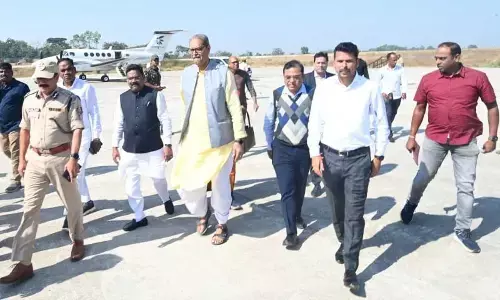Need for champions of change

In the columns of last week’s Hans India, we saw with what speed new districts have been carved out
In the columns of last week’s Hans India, we saw with what speed new districts have been carved out. Naturally, readers will be wondering whether these days also, such expensive and illogical decisions are being taken. It is not as if there are no examples of better administrative models before the country. Take for example, ‘Aspirational Districts Programme’ launched by the Union government by January 2018. This initiative aims to ‘quickly and effectively transform 112 most under-developed Districts across the country.’
Rolled out by NITI Aayog, this programme is distinguished by three important features of Convergence (of state and centre), Collaboration (among offices at various levels) and Competition (among districts). Ranking is accorded on the basis of performance in incremental progress made across 49 key performance indicators. In this regard, there are five broad socio-economic themes that are targeted for results. These themes are health & nutrition, Education, agriculture and water resources, financial inclusion and skill development, and infrastructure.
If achieving economic progress of poor households was the sole concern of the state governments, then why wasn’t this aspirational district programme emulated? There were three districts each from Telangana and from Andhra Pradesh included in this approach by the NITI Aayog. These states could have run a similar programme and focussed on a few more districts and showed progress and equity. This opportunity was not seized by the two state governments. They indulged in increasing administrative expenditure at a time when revenues were getting effected due to onslaught of COVID.
It is such a pathetic display of immaturity when the new districts have broken the momentum that was gained by development agencies in both the Telugu-speaking states. It appears that the state governments are not concerned to improve the living standards of the population in a substantive manner.The more visible optics were to run down the previous governments rather than targeting their own milestones. Schemes that would prove to be guzzlers for state resources became the obvious choice of the governments. Choice of new caste groups often appeared as a strategy for social engineering. Abolition of caste system is a distant dream in these circumstances.
In the last three to four decades, one has seen so many changes in the panchayatraj institutions. Telugu desam party even tried directly elected President for Zilla Praja Parishad at district level. District Collector who was the chairman of standing committee of Zilla Parishad was made a mere member in the revised scheme of local self government.
For some time, District Development and Review committee became the body to sanction development schemes at district level. For sake of political convenience, a Minister of non-local origin was notified as chairman of this committee. All these experiments have not shown any accelerated reduction in poverty. Here, the estimates of state administration were often at strong variance with estimates of national bodies. This awful gap between the two estimates is another drain on the state resources.
Food distribution is a case in point. There are no plausible explanations available to understand this gap between food grains allotted by union government and allotment made by state for public distribution system. If the multi-dimensional poverty index pegs deprivation at 20 per cent, food grains were being allotted for 80 per cent. One has to coin a better expression than ‘targeting error’ to describe this loot going in front of our eyes. In various ways in all the schemes and programmes such frittering away of precious resources is happening. Is it possible to put the finger on the pulse and suggest remedies that can provide some hope.
As stated before state governments can first identity those areas, pockets, households which require handholding and identify such mandals, divisions, districts for intense treatment. In those areas on an MoU basis, select officers of suitable seniority can be posted for a fixed tenure of 3 to 4 years. This officer can be given that precious immunity against interference of local public representatives in transfers and postings.
Further, professional assistance is provided to these ‘champions of change’ to design the programmes, delivery of same, conduct of evaluation and impact studies. The existing machinery created to undertake this intellectual exercise has lost its sheen and efficiency.
This body will prepare sector plans, skill upgrading programmes in the available ITIs, Polytechnics, Engineering colleges and private industrial establishments. On a saturation basis all the youth will be skilled, trained and coached to undergo the required transformation. Of course, farming requirements are the first priority for training.
Today, there is an upsurge in individual commitment to change. These are times of adoption of disruptive technologies and nurturing of life-changing ideas. Young professionals are risking their everything to persue innovation and entrepreneurship. Time is ripe to invite such committed individuals to identified rural, tribal and deprived pockets and allow the district administration to have MoU with them for a defined period. State governments can facilitate these groups to leverage funds apart from resources of state and adopt an arm’s length approach to get consistent results.
We have seen how committed individuals ran their voluntary organisations in an exemplary manner and luckily some of them are still around. Governments must shed their prejudices and suspicions against such bodies and make them partners in this Amrut Kaal campaign for growth and transformation.
In such a planned manner, these states can surely transform the outlook in these districts. Collectors would also end up feeling proud for the performance of the group entrusted with the task of development. These districts will thus take growth to next level. This song of rural development that is being heard from late 70s has outlived its utility. The people deserve a better deal and trained civil servants are capable to give more.
I am not pleading like yester year communist for state to wither away. There is so much more that the state has to support and fund. Look at the state of government hospitals. Many of the medical colleges are inadequately funded and infrastructure is awfully inadequate. So, tertiary medical care is solely available with private medical companies. Challenges at middle-level and grass-root level medical and public health institutions is of huge order. State-run universities are beset with a huge list of challenges.
Unfortunately Vice-Chancellor appointments are not usually considered on the basis of research or teaching experience. In the recent past, one saw Vice-Chancellors like Dr S Radhakrishnan, Dr CR Reddy, Dr K R Sreenivasa Iyyengar, Prof Sarveswara Rao, Prof Sachidananda Murthy, Prof Y C Simhadri engaging students for class-room teaching and research. Politics was only an occasional activity especially nationalistic movements originated there. Today caste wars are being undertaken on campus.
State government must restore puritanical values in these centres of higher learning and respect budgetary allocations made besides encouraging universities to raise resources. State governments can show better attention to building of infrastructure and provision of services if the list of ‘freebies’ can be carefully pruned and finally removed by such a wise approach as suggested above.


















